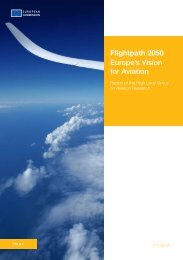Create
Final Report - Acare
Final Report - Acare
- No tags were found...
Create successful ePaper yourself
Turn your PDF publications into a flip-book with our unique Google optimized e-Paper software.
THE IDEAS<br />
IV.<br />
All these measures seem to have some effect<br />
but still the number of bird strikes is alarming.<br />
This is of special importance if airports would<br />
be constructed at sea.<br />
The idea that came up during the CREATE<br />
workshop was to avoid costly ground<br />
infrastructure and to emit sound from the<br />
approaching airplanes. The advantage would<br />
be that the airlines and airspace users which<br />
suffer from bird strikes are made responsible<br />
for bird strike avoidance rather than the<br />
airport operator. The introduction of a<br />
potential system will be fully scalable. New<br />
aircraft could be fitted with the sound device.<br />
A retrofit programme should be feasible.<br />
It is expected that ground based systems will<br />
stay in use for a number of years as there<br />
will be a long test period required and the<br />
introduction of a system will be gradual. The<br />
involvement of EASA is yet unclear, but EASA<br />
has at this moment no authority over bird<br />
strike prevention at airports. However as soon<br />
as the system is aircraft based, EASA will need<br />
to certify the system.<br />
Besides the frequency, the sound intensity<br />
(loudness) and the relevance of the signal<br />
play an important role. Acoustic signals<br />
have to meet 3 basic conditions: detectable,<br />
audible and relevant. Constant signals will be<br />
biologically irrelevant.<br />
The initial incubation study should identify<br />
the noise characteristics needed to scare<br />
away birds in the flight path of aircraft. Then<br />
it should verify if such a system would be<br />
acceptable for human beings in the vicinity of<br />
airports. Finally the outlines of such a system<br />
(location, energy requirements, loudspeakers,<br />
operations) should be established. It is<br />
important to evaluate the basic capability<br />
of the proposed system to achieve sufficient<br />
safety levels regarding bird strike threats. Only<br />
if these elements are researched and proven<br />
to be desirable and feasible, the system could<br />
be offered for regular research programmes.<br />
It is recommended to perform small scale tests<br />
during the incubation period to validate the<br />
feasibility of the system.<br />
The idea is to emit sound in front of the<br />
aircraft that will scare birds away. The sound<br />
should not be annoying to human beings.<br />
Therefore the original idea was to emit ultra<br />
sound waves in front of the aircraft. This<br />
would only be operated near airports and<br />
in airspace where concentrations of birds<br />
are detected by radar. The sound emitted by<br />
aircraft could be the result of noise sources<br />
located at strategic locations on the aircraft.<br />
The system should not only protect large civil<br />
airliners but also be adoptable to small aircraft<br />
and helicopters as most fatalities due to bird<br />
strikes fall in that category.<br />
The original idea was to emit ultra sound<br />
(20 kHz and above) in front of the airplane.<br />
Some studies indicate that ultrasound has<br />
been proven to be effective to scare birds off<br />
buildings. Other literature studies indicate that<br />
birds will not hear ultra sound or indicate that<br />
different bird species are sensitive to different<br />
frequencies of sound. For most, this is about<br />
1-4kHz (which is in the domain of audible<br />
sound of 101Hz to 20kHz) but some species are<br />
sensitive to lower and higher frequencies. Few<br />
species are sensitive to low frequency sound<br />
(20Hz - 100Hz) and a few may be to infrasound<br />
(below 20Hz). Tests in the UK may not have<br />
demonstrated any response from birds to<br />
infrasound emissions.<br />
83



